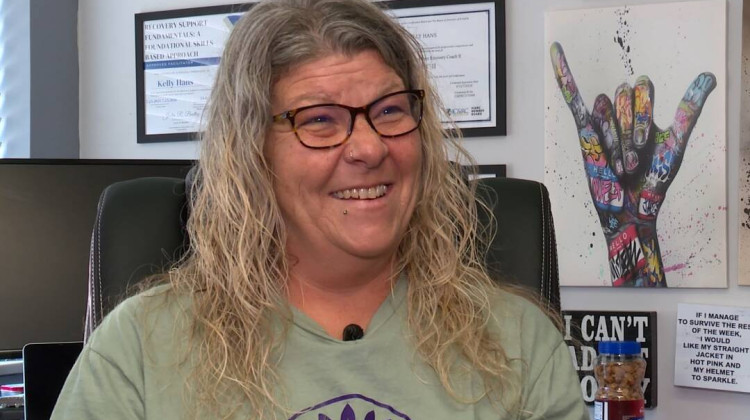
Dale Stout, 50, is one of the first people to benefit from the additional housing supports in California's new Medicaid initiative, CalAIM.
Ryan Levi / TradeoffsJacey Cooper is the director of Medicaid in California, and she’s never been afraid of big challenges.
She commuted two hours each way from Bakersfield to Los Angeles to complete her senior year at the University of Southern California after giving birth to twins.
Just a few years later, at 27, she helped a large county hospital lower costs and double the size of its program for uninsured and low-income patients by pairing them with care managers, who help them navigate the complex health care system and stay out of the emergency department.
Now, the 39-year-old has designed the nation’s most ambitious effort to push Medicaid coverage beyond the four walls of the traditional health care system.
CalAIM, which went live on Jan. 1, will touch almost all of the nearly 15 million people covered by Medi-Cal, California’s Medicaid program. It will add new dental benefits, change how Medi-Cal addresses addiction and mental illness, and expand the reach of managed care in the state, among other reforms.
But the most innovative piece of CalAIM is focused on a smaller group: people who lack a safe, stable place to live. With CalAIM, Cooper is betting that if Medi-Cal can help people get and stay housed, they will be healthier and cost the state less in the long run.

“It's more than just paying for an emergency room visit or paying for a clinic visit,” Cooper said. “We are caring for some of the most vulnerable, low-income individuals in this state, and our job is to do way more than that.”
Building a first-of-its-kind Medicaid program
CalAIM began to take shape in April 2018, when Cooper criss-crossed California to hear from Medi-Cal providers and insurers about what they thought was and wasn’t working in the program.
At almost every stop, she saw counties, hospitals and managed care plans working to address patients’ social problems to better address their health needs.
Cooper spent the next 10 months focused on turning what she learned into CalAIM.
One of the most challenging pieces was figuring out how to get the federal government to pay for things that were not traditional medical services. Each state runs its own Medicaid program but shares costs with the federal government, which has strict rules about what it will pay for. For example, federal Medicaid dollars cannot go toward paying someone’s rent.
All of the programs Cooper had seen during her listening tour were funded by health plans, counties or hospitals without Medicaid reimbursement, or they were part of small Medicaid-funded pilot projects.
Cooper remembers thinking to herself: “Here are all these things that are actually working for people that we haven't been able to find solutions for historically or we haven't paid for them. How do I find a way to pay for that? Because once you can pay for something, once you finance it and once there's sustainability, then it can grow.”
To find that financial sustainability, Cooper turned to “in lieu of services,” a part of federal Medicaid regulations that allows managed care plans to pay for — and get reimbursed for — non-traditional medical services, as long as they had a connection to a patient’s health and had data showing they were cost-effective and improved care.

Over the course of two to three months, Cooper and her colleagues whittled their list down to 14 “community supports” that would be core pieces of CalAIM. Almost all of them were related to housing, from helping someone find an apartment and pay first month’s rent to keeping someone in their home by paying to remove mold from the walls or installing bathroom grab bars.
“By allowing someone to get housed, they can start thinking about how they're going to address some of the other things in their life because they are not worried about where they're going to sleep or what they're going to eat that day,” Cooper said, summing up the philosophy behind the new services.
Cooper paired the community supports with another new benefit in CalAIM, enhanced care management, which would provide patients with a care manager to help them coordinate all of their medical and social needs.
Cooper spent 2020 and 2021 convincing state and federal officials to sign off on CalAIM before ultimately getting the final thumbs up from the federal Centers for Medicare and Medicaid Services a few days after Christmas 2021.
“I came home and my husband opened a bottle of champagne and, of course, I wrote CalAIM on that cork and I will keep it for a very long time,” Cooper said.
CalAIM in action
Dale Stout is one of the first people in California to benefit from CalAIM.
Stout had a stroke earlier this year, and while he was in the hospital, the bank took his home.
“It came down like a ton of bricks,” he said.
Stout feared he would end up in a shelter or on the streets, but a hospital social worker referred him to Illumination Foundation, a nonprofit that runs housing and health care programs across Southern California.
Thanks to CalAIM, Stout’s Medi-Cal insurer paid for him to stay at Illumination Foundation’s medical respite facility in Riverside, where he was able to continue his recovery. CalAIM also paid for a caseworker to help Dale look for a new place to live and apply for housing assistance.
“If [Illumination Foundation] hadn't stepped in and taken me, I would have been on the streets,” Stout said. “I'd be dead.”
Instead, Stout has relearned how to walk, maintained his sobriety, made it to all of his medical appointments and is scheduled for brain surgery this fall.
An ambitious program with many challenges
Stout’s story is also emblematic of one of the biggest challenges facing CalAIM: housing availability.
Months after he was healthy enough to have moved into his own place, Stout was still at Illumination Foundation waiting for a housing voucher to come through, something CalAIM can do little to change.
“It is hard when you have certain parts of the puzzle really working right, and then you hit a limitation that you don't fund,” Cooper, CalAIM’s architect, said.
Stout is on track to get a voucher before he has to leave Illumination Foundation in December. But California is still facing a homelessness crisis. The latest estimates put California’s homeless population around 161,000, a far greater number than the 3,800 people CalAIM has helped look for a place to live, or the 5,900 it’s helped to stay in their homes.
Other concerns center around the basic mechanics of pulling off a program this ambitious: Will the program find enough social service providers to offer these new services? Can those providers adapt to the bureaucratic, administrative burdens of Medicaid? Will doctors, nurses and social workers even know about CalAIM to refer patients?
A major concern of consumer advocates in the state is whether managed care plans — which are responsible for providing these new non-traditional services — will be able to deliver.
“Those health plans do not have the best track record, even with providing some of the basic core health care services — childhood vaccinations, providing access to the primary care and specialists that patients need,” said Anthony Wright, executive director of Health Access California.
Managed care plans are not required to offer community supports, but as of July 1, all 24 plans were offering at least two.
Will CalAIM help patients and save money?
Paula Lantz, a researcher at the University of Michigan who has spent decades studying attempts by Medicaid to improve health by addressing patients’ social needs, is worried about claims that CalAIM will save the state money.
While some studies have shown that getting people housed and providing them with supportive services saves money in the long run, Lantz points to a 2019 literature review she co-wrote that found connecting complex patients to social services rarely improved outcomes or lowered costs compared to similar patients who received traditional medical care.
“These kinds of interventions are often oversold to get the political buy-in and to get the resources by saying they're going to be cost neutral,” Lantz said. “My biggest worry is that there could be very positive impacts of what they're doing that don't show up in a bottom line, and then it just makes people not even want to invest in it any further.”
Cooper is confident CalAIM will save money because so many of these services did just that as local pilots. Her department estimates that if emergency room, hospitalization and long-term care use drops just 3.3 percent by 2026, that would offset the costs of the new community supports.
But that’s not the most important outcome in her mind.
”We should be prudent with taxpayers’ dollars, but if people's health outcomes are improving and they're getting access to the appropriate services they need, I think overall that is success. That is what we are trying to do,” Cooper said.
Cooper knows implementing CalAIM will be a long and messy process, but she’s committed to the idea that Medicaid can and should do more for its most vulnerable members.
“I think it's just increasing the bar of what we should be doing, what our society should be doing,” she said. “So it's a huge opportunity, and I hope that we meet the moment.”
This story comes from the health policy podcast Tradeoffs, a partner of Side Effects Public Media. Dan Gorenstein is Tradeoffs’ executive editor, and Leslie Walker is a reporter/producer for the show, which ran this story on September 22. Tradeoffs' coverage of health care costs is supported, in part, by Arnold Ventures and West Health.
9(MDAyMzk1MzA4MDE2MjY3OTY1MjM5ZDJjYQ000))
 DONATE
DONATE






 Support WFYI. We can't do it without you.
Support WFYI. We can't do it without you.